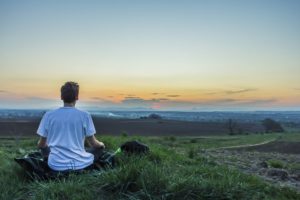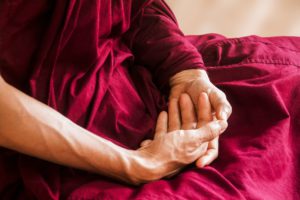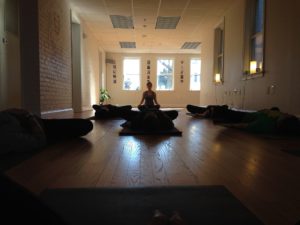
With that said, in this article, I’m going to mainly talk about the different kinds of techniques there are. You can use them during one of your yoga routines, but some can even be done while you are at work, school, etc. One thing I’d just like to say, and this is very important, pranayama comes after doing the asanas.
Yoga and Pranayama are connected and there is a reason why pranayama comes after asana. While doing the asanas you’re giving your body a stretch. This means that you are opening your body to be more receptive to oxygen. And therefore you’ll benefit more from the pranayama techniques when you are doing them after your yoga practice.
The pranayama breathing techniques that I’ll be talking about are the following:
- Kapalabhati
- Nadi Shodana:
- Surya Bhedi
- Chandra Bhedi
- Ujjayi
- Bhastrika
- Bhramari
Before You Begin
A small disclaimer before you start doing these pranayama activities: it might be advisable to check with your doctor if you don’t have any health conditions that will interfere with this practice. I will also put down the warnings with each breathing routine, but I’m not a doctor and I can’t give any medical opinions.
Besides that, here are some suggestions while doing pranayama:
- Sit in a comfortable position where your abdomen won’t be obstructed;
- Choose a space where you won’t be disturbed by external stimuli;
- Crack the window open a little for good airflow in the room (if you are not living in a polluted area);
- Make sure the room is enjoyable regarding temperature.
Kapalabhati Pranayama
Kapala means skull and Bhati means shining. So this pranayama is translated into skull shining breath. It has this name because it’s not only a breathing method but also considered a cleansing technique. Because of the rapid breathings that you’ll be taking, you’ll be cleansing your blood as well. It’s been said that this causes a glow, which is why it has been named skull shining breath.
How to:
When you are seated in a comfortable position with your spine straight, focus on your breathing. First of all, start breathing normally and deeply. After that, you start focussing on your exhalations. Make them quick and deep, your breath is fast now. Be aware of the movement of your tummy, this is the only part moving at this moment. If you are experiencing difficulties doing this breathing technique, try to put your hand on your stomach to move your awareness there.
Start with 10 exhales and after that do 3 normal breathings. Do this series 3 times. When you are more advanced, you can go all the way up to 30 exhales and 3 normal breaths for three rounds.
Effects:
- Helps prevents pimples and wrinkles
- Good for:
- Sinusitis
- Digestion
- Gastritis
- Dandruff
- Headache
Contraindication:
Don’t do this technique when:
- Pregnant
- Asthma
- High blood pressure
- Ulcer
- Brain tumor
- Epilepsy
Nadi Shodana
This breathing method is also known as the alternate nostril breathing. It is to clear your energy channels and align all meridians in your body.
How to:
With your right hand place your middle finger and index finger on your third eye. The little finger and ring finger should be used to close the left nostril and the thumb to close the right nostril. Start closing off one of them to begin. Start your inhalation through the open nostril. When you’ve completed this, close this nostril off and open the other to exhale through there. Inhale through this open nostril, close off and open the other one for the exhalation.
Effects:
This breathing exercise is said that it balances everything and if you decide to only do one technique, it should be this one.
Contraindication:
With this technique, there aren’t any don’ts. This is a very safe technique, it’s only advisable not to retain the breath when you are having heart issues.
If you are having a cold, which makes it harder to do the full routine, try to use Surya Bhedi or Chandra Bhedi.
Surya and Chandra Bhedi
These two breathing techniques are quite similar. The only thing is that you don’t shift your nostrils.
With Surya Bhedi you only use the right nostril. So inhaling and exhaling happen through the right hole. And with Chandra Bhedi it is the other way around.
Ujjayi Pranayama
With this one, I had difficulties myself in the beginning. It’s mostly used during the practice of vinyasa yoga. With this pranayama, you make a sound from your throat. It sounds a bit like a calm and soothing ocean.
How to:
I used to have a lot of difficulties mastering this pranayama. And especially during the rapid movement within a vinyasa yoga practice. How I finally managed to do it was by practicing my Darth Vader voice. It has the same principle more or less. While breathing you control the movement of your larynx, closing it down a little to make a sound coming from your throat.
If you feel dizzy after 15 minutes, go back to your normal breathing.
Good for:
- Boost immune system
- Bones
Contraindication:
Don’t do when:
- Throat or ear infections
- Cancer or tumor in the neck
Bhastrika Pranayama
This one is focussed on dynamic breathing. Do this one during the winter to warm up your body!
How to:
This pranayama is done by forcefully inhaling and exhaling. Watch out, this doesn’t mean that your breathing is superficial and fast. Try to manage deep breathing from your gut. Sometimes it even helps to forcefully push your belly in and out while doing this exercise. 20 breathings per round should be enough.
Good for:
- Cold (temperature and having a cold)
- Sinusitis
- Low blood pressure
Contraindication:
Don’t do when:
- Pregnant
- High blood pressure
- Brain tumor
- Epilepsy
- Asthma
Bhramari
Bhramari is Sanskrit for humming bee. And with the sound that you’ll be producing, you’ll immediately know where this name comes from.
How to:
Close your eyes to draw your awareness within. Put your index fingers in your ears, if you happen to have a small ear infection, then put the fingers on the tragus to close down the entrance of your ear. Keep your mouth closed and start making a humming sound. If you do this for the first time, start by doing this breathing technique 5-10 breaths long.
Good for:
- Mental relaxation
- Physical and mental diseases
- Activates neurons and pineal gland
Contraindication:
Don’t do when:
- Brain tumor
- Chronic migraine
- Cold
Conclusion

I suggest you try some of the techniques yourself if you want and let me know in the comment section below what you thought of them!
The next article will be about Pratyahara, so stay tuned in.
Nama-stay wonderful!






Glad you finally share the article on pranayama and I’m glad that I could read it. Getting to master the art embedded in yoga breathing is really great. This was the first thing introduced to me when I started last week and I’m glad I could finally get enough information on it through this platform. I never knew it has this much types and the topic us very wide. I would keep up with it a d make sure to keep learning. Thanks so much for sharing this. Thumbs up
Thank you Mattias for your comment! I’m glad you liked the article!
It’s very nice to learn about all this breathing techniques and I am happy I came across this post now. The pranayama is something that we were told in our yoga class that we will be doing this coming week so I wanted to know about it. I didn’t realise that there are so many steps to do and many poses to take too. Well, I must say, Thank you for teaching me all this as it will help me be better in class this coming week.
Hi Henderson, there are so many things to learn from yoga, the asanas are merely the tip of the iceberg ;). Enjoy your yogic journey and let us know every know and then how you are experiencing it!
It seems the Nadi Shodana very much achievable by me eight now and I’d give it a go straight up. Thanks for sharing all these techniques to doing pranayama. I learnt that pranayama is one of the most integral and core value of yoga because it has do with breathing and ensuring that one takes note of their self and the body in general. Mastering the mind and teaching to be more calm. Hence, I really fancy doing this and mastering it. I got the positioning already and I’d get right at it now. Thumbs up
Hi Shelley, The nadi shodan can practically done by everyone and it’s a good way to start or end your day! Feel free to let me know how you experienced the technique!
Thank you for breaking down the meaning of pranayama and telling us what the words mean. I believe that breathing exercises are the best because in our world, breathing is one of the most essential parts of our lives. It’s nice to learn what you have written here and you have also illustrated different pranayama breathing techniques. This is very good. I will try them myself at home. Thanks again
You’re welcome John and enjoy these techniques! Let us know how you have benefited from them!
So far I have come to understand how effective yoga exercises can be and over time I haven’t been paying attention to it and funny enough my husband does yoga exercise. I am someone who have busy life style and I am always stressed and disturbed all the time keeping up with work and kids isn’t easy. I’ll love to try Bhramari and with high hopes, I know it will be effective in helping me relax my mind. I’ll go check the video out now. Best regards
Hi Chloe, enjoy the Bhramari ;). But do it slowly in the beginning, if you’ve never done this before it’s best to start with just five hummings and then lie down for a while.
It seems the Nadi shodana is very much achievable by me eight now and I’d give it a go straight up. Thanks for sharing all these techniques to doing pranayama. I learnt that pranayama is one of the most integral and core value of yoga because it has do with breathing. With this i can learn to master my mind and be more calm in times of crisis or stress. I got the positioning already and I’d get right at it now. Thumbs up
It is only until recently that I realized the importance of controlled breathing. I am sure most people have never thought to relax and breath themselves out of situations. It is very interesting to know that there are all those different types of Pranayama techniques. I am intrigued by the Kapalabhati Pranayama. Sounds like something I would like to do to get that glow. I am surprised that it controls dandruff?
The methods of doing these exercises do not seem complicated a lot. Thank you for sharing such intriguing techniques and their benefits. Great article!
Hi Carol, thank you for your comment. Yes, indeed the exercises aren’t that hard, and you can easily to them yourself at home! That’s why I wanted to bring these breathing techniques to everyone’s attention as they are somehow a bit forgotten I feel in yoga.
Very informative post on breathing techniques. I do yoga myself and I normally do Ujjayi breathing. I like how you structured the content and the videos are an added bonus – sometimes its difficult to explain techniques like this with just text or pictures.
Do you have any recommendations on the best time to practice meditative pranayama? I’ve always contemplated if it was best in the morning or before going to bed. Would love to hear your comments on that.
Hi Mark, thank you for your question. In general, it depends on which pranayama you’d like to do. In the morning I’d go with a more strong pranayama technique, like the kabalabhati and in the evening I’d go with a more soothing method like bhramari. This because they all have a different effect. Doing an energizing pranayama technique before going to bed, well… I can tell you that you won’t be sleeping so well that evening ;).
Nadi Shodan you can do anytime you want!
Hi there,
It is fulfilling to read how different ways of breathing control can help cure different symptoms which can be deadly sometimes if not treated.
My sister-in-law who I live with now is a regular practitioner of all of the important pranayamas that are described in your blog.
The benefits she has got in real life:
1. Increased positivity
2. Regular menstruation which had a problem with earlier
3. Increased self-confidence
4. Taking responses from others positively
5. Increased mental peace
6. Loss of 68 Kg to 55 Kg over 3 months only.
Kapalvati has benefited me personally as well. The direction I follow is much different than the video describes here. I exhale heavily so one can hear when I exercise. I learned how to do it now from this blog.
Breathing defines if we are alive or dead. It is that important. It is important to learn how to breathe in the fast-moving and stressful current world.
I like to add the importance of diet along with exercises for optimal performance of organs and mind.
Thank you for sharing this important piece of beneficial information which does not cost a dime and you can do from the comfort of your home.
Hi Anusuya, thank you for your comment and your and your sister’s experience with pranayama! It’s good to hear from other people how they’ve benefited from these exercises! And about the food, that’s an excellent remark you’ve got there, maybe in the future I’ll do an article about yoga and food as well! I’ve got some small pieces on food scattered over my blog, so maybe it’s time to dedicate a blog about food as well.